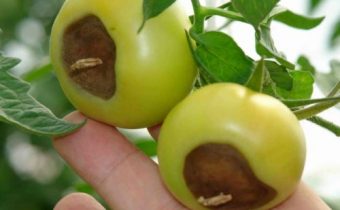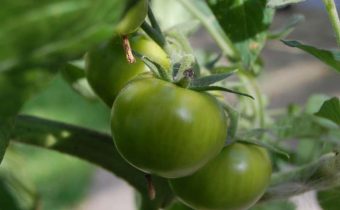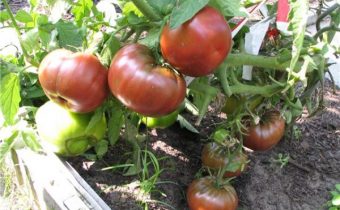Methods of dealing with the apical rot of tomatoes

Quite right this disease. Vertex rot of tomatoes in the greenhouse and their treatment is quite problematic, since it has two reasons:
- Bacterial origin;
- Non-infectious.
Bacterial Vertex Rot
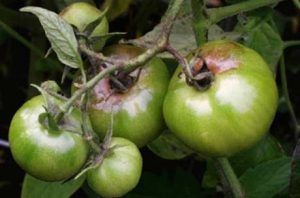 The cause of bacterial apical rot is a bacterium. Manifestation of the disease with the beginning of the growth of the fruit. With increasing humidity, the lesion becomes soft, the mass softens and acquires a peculiar smell. Carriers of the pathogen can be both the number of sticks and insects. Very often, the pathogen is entered along with the seeds, so the fight against tomato rot must begin at the time of presowing preparation. It is enough to soak tomato seeds in a 0.5% solution of potassium permanganate and the seminal pathway of the disease will be interrupted.
The cause of bacterial apical rot is a bacterium. Manifestation of the disease with the beginning of the growth of the fruit. With increasing humidity, the lesion becomes soft, the mass softens and acquires a peculiar smell. Carriers of the pathogen can be both the number of sticks and insects. Very often, the pathogen is entered along with the seeds, so the fight against tomato rot must begin at the time of presowing preparation. It is enough to soak tomato seeds in a 0.5% solution of potassium permanganate and the seminal pathway of the disease will be interrupted.
See also: Varieties of tomatoes of Siberian selection with photos and descriptions
At the first signs of the disease, treatment of greenhouse tomatoes with the “Fitolavin VRK” preparation can be applied by diluting the preparation with 20 ml per 10 l of water. If last season your tomatoes already succumbed to this disease, then it is necessary to water the tomatoes from the seedling period, when there are 2-3 true leaves on sprouts, then after disembarking to a permanent place, and then with an interval of 12-15 days. 35-40 ml of the working solution must be applied under the seedlings, and no less than 150 ml under the adult plant. The drug is fast enough, well penetrates through the vascular system of the plant. It is enough one season to carry out thorough treatments with this preparation in order to forget about bacterial apical rot for a long time. Treatment with this drug will be a prophylaxis for soft tomato rot, tracheomycotic wilt, root collar rot.
Non-infectious Vertex Rot
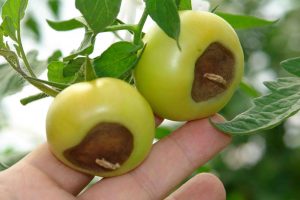 The cause of non-infectious vertex rot can be a lack of calcium, irregularity of irrigation, and strong drops in night and day temperatures in the greenhouse. To distinguish infectious or non-infectious nature of the disease it is necessary to examine the affected fetus itself. It is enough to reveal that the affected apical part does not soften, and the fabric is dark brown, sometimes even black. If non-infectious vertex rot of tomatoes still occurs, treatment should begin with monitoring and controlling the ambient air temperature in the greenhouse. Airing in time, with abnormal daytime heat and cold nights does not help much, but it is quite possible to adjust the watering, to hold them regularly, with warm water.
The cause of non-infectious vertex rot can be a lack of calcium, irregularity of irrigation, and strong drops in night and day temperatures in the greenhouse. To distinguish infectious or non-infectious nature of the disease it is necessary to examine the affected fetus itself. It is enough to reveal that the affected apical part does not soften, and the fabric is dark brown, sometimes even black. If non-infectious vertex rot of tomatoes still occurs, treatment should begin with monitoring and controlling the ambient air temperature in the greenhouse. Airing in time, with abnormal daytime heat and cold nights does not help much, but it is quite possible to adjust the watering, to hold them regularly, with warm water.
See also:How to feed tomato seedlings to be plump?
How to deal with top rot on tomatoes using fertilizing? When detecting the first signs of tomato damage, regular calcium foliar dressings should be carried out.
To do this, you need to prepare a solution of calcium nitrate at the rate of 5g per bucket of water and process all plants and the surrounding land 2 times a week. Such processing can be carried out with the preventive purpose.
The balance in irrigation and calcium deficiency are interrelated.The fact is that in the soil there is absolutely enough such an element as calcium, but in conditions of low humidity, this element is not available to the tomato. By balancing the irrigation, adjusting the water-elemental digestibility process, you can completely eliminate the vertex rot without going into additional measures. If the temperature is very high, and the leaf plates evaporate a significant amount of water, watering once a week is unacceptable. Daily watering is necessary for tomatoes.
See also:Planting tomatoes in the greenhouse requires a competent approach
If top rot bothers tomatoes from year to year, remember whether the soil was prepared properly when laying the greenhouse. If there is no possibility to analyze the soil, it is necessary to conduct soil liming in the fall. Adding lime and ash, under the autumn digging will also help to cope with the problem.
Crop rotation. Refuse to grow tomato and other solanaceous, in the greenhouse for 1-2 seasons. The soil will improve, and top rot will leave your greenhouse.
Tomato rot in a greenhouse can sometimes take up to 15% of the crop. Conducting proper preparation of soil and seeds, airing and watering, keeping the greenhouse clean, you can easily eliminate the disease, no matter what its nature.


